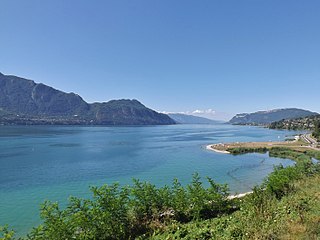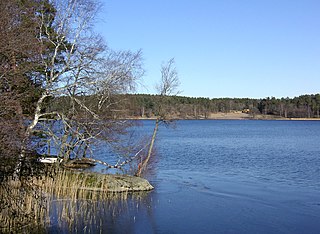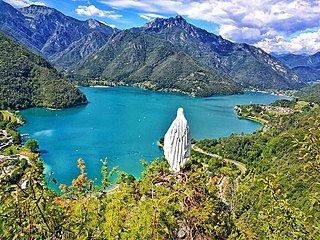
Grand Lake St. Marys State Park is a public recreation area located on 13,500-acre (5,500 ha) Grand Lake in Mercer and Auglaize counties, Ohio. Grand Lake is the largest inland lake in Ohio in terms of area, but is shallow, with an average depth of only 5–7 feet (1.5–2.1 m). The state park is open for year-round recreation, including boating, fishing, swimming and hunting. The park consists of the lake and park facilities scattered all around the shore intermingled with private property and a facility operated by Wright State University. It is west of St. Marys, and southeast of Celina, 23 miles (37 km) southwest of Lima in the northwestern part of the state.

A meromictic lake is a lake which has layers of water that do not intermix. In ordinary, holomictic lakes, at least once each year, there is a physical mixing of the surface and the deep waters.

Saxitoxin (STX) is a potent neurotoxin and the best-known paralytic shellfish toxin. Ingestion of saxitoxin by humans, usually by consumption of shellfish contaminated by toxic algal blooms, is responsible for the illness known as paralytic shellfish poisoning (PSP).

Laminaria is a genus of brown seaweed in the order Laminariales (kelp), comprising 31 species native to the north Atlantic and northern Pacific Oceans. This economically important genus is characterized by long, leathery laminae and relatively large size. Some species are called Devil's apron, due to their shape, or sea colander, due to the perforations present on the lamina. Others are referred to as tangle. Laminaria form a habitat for many fish and invertebrates.

Lac du Bourget, also locally known as Lac Gris or Lac d'Aix, is a lake at the southernmost end of the Jura Mountains in the department of Savoie, France. It is the deepest lake located entirely within France, and either the largest or second largest after Lac de Grand-Lieu depending on season.

Geosmin is an irregular sesquiterpenoid with a distinct earthy or musty odor, which most people can easily smell. The geosmin odor detection threshold in humans is very low, ranging from 0.006 to 0.01 micrograms per liter in water. Geosmin, along with the irregular monoterpene 2-methylisoborneol, together account for the majority of biologically-caused taste and odor outbreaks in drinking water worldwide and in farmed fish. Geosmin is also responsible for the earthy taste of beetroots and a contributor to the strong scent, known as petrichor, that occurs when rain falls after a spell of dry weather or when soil is disturbed.

Trachelomonas is a genus of swimming, free-living euglenoids characterized by the presence of a shell-like covering called a lorica. Details of lorica structure determine the classification of distinct species in the genus. The lorica can exist in spherical, elliptical, cylindrical, and pyriform (pear-shaped) forms. The lorica surface can be smooth, punctuate or striate and range from hyaline, to yellow, or brown. These colors are due to the accumulation of ferric hydroxide and manganic oxide deposited with the mucilage and minerals that comprise the lorica. In Trachelomonas, the presence of a lorica obscures cytoplasmic details of the underlying cell. In each Trachelomonas cell, there is a gap at the apex of the lorica from which the flagellum protrudes. Thickening around this gap results in a rim-like or collar-like appearance. During asexual reproduction, the nucleus divides yielding two daughter cells one of which exits through the opening in the lorica. This new cell then synthesizes its own new lorica.

Flaten is a lake in southern Stockholm, Sweden, located just north of Lake Drevviken. The name is also used for the surrounding area and the nature reserve created there in 2007.

Anthony Edward Walsby, FRS was a Professor of Microbiology at the School of Biological Sciences, University of Bristol.

2-Methylisoborneol (MIB) is an irregular monoterpene derived from the universal monoterpene precursor geranyl pyrophosphate. MIB and the irregular sesquiterpene geosmin together account for the majority of biologically-caused taste and odor outbreaks in drinking water worldwide. MIB has a distinct earthy or musty odor, which most people can easily smell. The odor detection threshold of MIB is very low, ranging from 0.002 to 0.02 micrograms per liter in water. MIB is also a factor in cork taint in winemaking.

Lago di Ledro is a lake in Trentino, northern Italy. The lake is at an elevation of 655 metres (2,149 ft), and its surface area is 2.187 km2 (0.844 sq mi).

Andryala is a genus of flowering plants in the family Asteraceae. It is native to Europe, North Africa, and the Middle East.

Planktothrix is a diverse genus of filamentous cyanobacteria observed to amass in algal blooms in water ecosystems across the globe. Like all Oscillatoriales, Planktothrix species have no heterocysts and no akinetes. Planktothrix are unique because they have trichomes and contain gas vacuoles unlike typical planktonic organisms. Previously, some species of the taxon were grouped within the genus Oscillatoria, but recent work has defined Planktothrix as its own genus. A tremendous body of work on Planktothrix ecology and physiology has been done by Anthony E. Walsby, and the 55.6 kb microcystin synthetase gene which gives these organisms the ability to synthesize toxins has been sequenced. P. agardhii is an example of a type species of the genus. P. agardhii and P. rubescens are commonly observed in lakes of the Northern Hemisphere where they are known producers of potent hepatotoxins called microcystins.

Lake Vrutci is an artificial lake in western Serbia, in the municipality of Užice. The lake was created in 1983 by damming the Đetinja River, near the village of Vrutci. It was created with the purpose of supplying water to the city of Užice. It is narrow, around 7 km long, and lies at an altitude of about 700 m.
Cyanopeptolins (CPs) are a class of oligopeptides produced by Microcystis and Planktothrix algae strains, and can be neurotoxic. The production of cyanopeptolins occurs through nonribosomal peptides synthases (NRPS).

Caulerpa agardhii is a species of seaweed in the Caulerpaceae family.

Oscillatoria brevis is a species of the genus Oscillatoria first identified in 1892. It is a blue-green filamentous cyanobacterium, which can be found in brackish and fresh waterways. O. brevis can also be isolated from soil.
George S. Bullerjahn is an American microbiologist, a former Distinguished Research Professor at Bowling Green State University in Ohio. He is the founding director of the Great Lakes Center for Fresh Waters and Human Health. His specialty is microbial ecology; his research has focused on the health of the Laurentian Great Lakes, particularly the harmful algal bloom-forming populations in Lake Erie since the early 2000s.

Achnanthidium is a genus of diatoms belonging to the family Achnanthidiaceae.

Mastocarpus is a genus of red algae belonging to the family Phyllophoraceae.
















